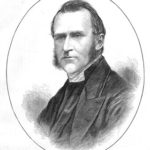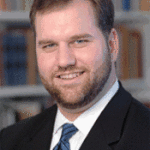ACADEMIC ORTHODOXY AND THE ARMINIANIZING
OF AMERICAN THEOLOGY
From the Wesleyan Theological Journal
James E. Hamilton
Asbury College
During the decades immediately before and after 1800 a massive shift began to take place in American theology. The dominant Calvinistic framework gave way and was succeeded by a prevailing Arminianism. So fundamental were the issues of this intellectual revolution and so profound were their implications that the Protestant Reformation has been called by comparison “a negligible theological performance.” 1
Calvinism had hit a low ebb before the days of the American Revolution. The basically deterministic formulations of Jonathan Edwards and his followers were increasingly looked upon as both theologically indefensible and morally repugnant. The attempt to maintain a form of determinism and yet to extricate from God responsibility for sin was straining the ingenuity of Edwards’ most capable followers. The idea that God would arbitrarily elect some to salvation and allow others to remain forever in their degraded and sinful condition was repugnant to the keen sense of fair play of American frontiersmen. A number of reactions appeared. Among the best known were the Enlightenment, Unitarianism, and that reaction to the Unitarian reaction, transcendentalism. None of these, however, were genuinely popular movements.
What did make headway with the general public was freewill, revivalistic, pietistic, Trinitarian Evangelicalism spearheaded by a group of academic leaders who have come to be known collectively as the “academic orthodoxy.” It will be our purpose in this study to characterize Evangelicalism during this period, to point out some of the reasons for its success, to identify academic orthodoxy, and to discuss the role of the orthodoxy in effecting the demise of Calvinistic supremacy.
We shall also focus attention upon the man who was perhaps the most complete single representative of this movement, Asa Mahan. The relevance of our discussion to the specific interests of the Wesleyan Theological Society is to be found in the fact that although this movement emerged phoenixlike out of Calvinism, it ran parallel to and mingled increasingly with Methodism, and, finally, with Methodism it gave rise to the holiness movement of the latter half of the century. This study will thus also provide a backdrop and context for Professor Dayton’s paper, “Asa Mahan and the Development of American Holiness Theology.”
In his analysis of the nature of the evangelical movement during the last century, William McLoughlin says,
The history of Evangelicalism in America must be told on three levels: first as philosophy, second as theology, and third as social history. As philosophy it is the story of the permeation of nineteenthcentury thought with the ideas and system of the Scottish Common Sense School. As theology it is the story of the decline of Calvinism, the Protestant Counter Reformation against deism, and the emergence of a new theological consensus on Arminian principles which prevailed between the Second Great Awakening and the rise of Modernism. As social history it is the story of the final triumph of voluntarism over establishment arianism and the rise of a new revivalistic religion which was as interdenominational in its pattern as the moral reform crusades and benevolent associations which it spawned to purify the nation and redeem the world. 2
This is the movement which from the beginning of the nineteenth century took America by storm. So influential was it that McLoughlin again writes,
The story of Evangelicalism is the story of America itself in the years 1800 to 1900, for it was Evangelical religion which made Americans the most religious people in the world, molded them into a unified, pietisticperfectionist nation, and spurred them on to those heights of social reform, missionary endeavor, and imperialistic expansionism which constitute the moving forces of our history in that century. 3
One reason for the success of Evangelicalism was that it was intellectually respectable. These men cultivated the vigor and integrity of their rational powers. Is it not significant that the chief revivalist of the era could be accused by Princeton theologians of being a cold logician.4 and that his Lectures on Revivals of Religion can be characterized today as “a major work in the history of the mind in America”? 5 The Evangelicals interpreted Christian experience itself as a matter of fidelity of the will to reason rather than to feeling. As we shall see, these men produced convincing philosophical arguments in defense of the will’s freedom and against the universal determinism of Edwards.
Their influence was keenly felt in academia also. D. H. Meyer points out that the American system of higher education in the nineteenth century has been aptly described as “Protestant Scholasticism” because of its ambitious effort “to organize all knowledge, including knowledge of the cosmos, of men, and of society, into a consistent and intelligible whole,” establishing a correspondence between secular knowledge and basic Christian principles.5
Hand in glove with the intellectual defense of freedom was the revivalistic emphasis of the Evangelicals. Of course the Calvinist Edwards was responsible for much of the religious impetus giving rise to the nineteenth-century revivals. The irony of this, however, is that if a revival is a mysterious, unexpected, inexplicable visitation from God, as Edwards held that it is, then whatever a person might say or do to produce one is irrelevant. Whatever is determined to be will be.
The Evangelicals maintained a different position. In their view the atonement had been provided and the grace of God was as a great reservoir waiting to be drawn upon. It was up to the individual to meet God’s conditions, to appropriate God’s grace, to choose to allow God to do something for him, to accept Jesus Christ as one’s Saviour. Revivals took work. People needed to be persuaded that what they did made a difference. Thus it was that people began to speak of revivalism, of the promotion of revivals, of the anxious seat, and of camp meetings; so Perry Miller can say in retrospect that “the dominant theme in America from 1800 to 1860 is the invincible persistence of the revival technique [italics mine], coming to its resplendent triumph in the Third Awakening of 185758.”7
The popular character of Evangelicalism is most clearly seen in this revivalistic emphasis. “Generally considered,” says Perry Miller, “the period following 1800 was, for about forty years, one of massive revivals.”8 Though often treated as peripheral, revivals may have been the decisive element in determining the character of our nation. As Miller says, “They gave a special tone to the epoch; through them the youthful society sought for solidarity, for a discovery of its meaning.”9 He further says,
Indeed one can almost say that the steady burning of the Revival, sometimes smoldering, now blazing into flame, never quite extinguished (even in Boston) until the Civil War had been fought, was a central mode of this culture’s search for national identity. 10
In Miller’s view it was not Thomas Jefferson, or Madison, or Monroe who led America out of the eighteenth century, but Charles Grandison Finney, ll the man who “incarnated the aspiration and the philosophy of the revival.”12
Evangelicalism was particularly congenial with the democratic sense of the new republic. The Evangelicals tended to be democratic theologically, temperamentally, and institutionally. Jacksonian democracy was a curious blend of individualism and community awareness and aspiration. The model and chief inspiration of this democratic spirit was in fact the revival. In every revival men were held strictly responsible for their own actions. They were called as individuals to make peace with their Maker. Yet the revival was by its very nature a communal enterprise. Its methods were brought to bear upon whole towns, villages, and even cities. Individuals were summoned, as Miller points out, in order that “all might participate in the mystery of communion, even to selfabasement before the eyes of the fellowship.” 13 The proof of a genuine revival was that a community now acted as a community.
We are now prepared for an identification of the academic orthodoxy and for a discussion of its role in accomplishing the transition from Calvinism to Arminianism in American theology. In order to meet the rising demand for ministers, many new colleges were founded during the first 40 years of the century. In most cases these colleges represented the new school, or freewill brand of Protestantism, and produced ministers of the nonCalvinistic, liberal type. The term academic orthodoxy is usually applied to the philosophical academicians in most of the older colleges, except Princeton and a few others, and to the teachers in the burgeoning new colleges. Concerning these men, E. H. Madden says:
The members of the “orthodoxy” generally exhibited the syndrome of ministerphilosophercollege president.14 In addition to Wayland, Mahan, Finney, and Fairchild, the following names, at least, would have to be included in any representative roster: Jeremiah Day (Yale), Henry P. Tappan (New York University), Laurens Perseus Hickok (Union), Thomas C. Upham (Bowdoin), Noah Porter (Yale), Francis Bowen (Harvard), James McCosh (Princeton), Mark Hopkins (Williams), Andrew Preston Peabody (Harvard), Taylor Lewis (New York University), and Leicester A. Sawyer (Central College, Ohio) . 15
The academic orthodoxy not only emphasized a nonCalvinistic, freewill, evangelical brand of Christianity; it defended its views within the context of the Scottish realistic philosophy of Thomas Reid and his followers. Thomas Reid (171096) was a Presbyterian clergyman who left the ministry to devote his intellectual talents to the development of a philosophical system which would both undermine and replace the skepticism of David Hume. It is, of course, an irony of history that Reid was inadvertently to undermine Presbyterian Calvinism in America. According to Baruch Brody:
Reid was convinced that Humean scepticism was the logical conclusion of the whole of philosophy since Descartes and Locke and not merely the product of an ingenious and sophistic mind, and he saw his own psychological theories as the basis for the only approach that could avoid this devastating scepticism. 16
According to Reid, skeptical conclusions are the logical outcome of a faulty methodology. Instead of starting out with hypotheses and analogies drawn from the physical world, the mental philosopher should begin with the data of introspection, the dictates of common sense. Admittedly, the task of the philosopher in defending common sense is restricted. He can argue against objections and proposed alternatives to common sense intuition, but he cannot prove these data by deduction from more evident premises. Since they are first principles, the dictates of common sense are held to be self-evident and incapable of derivation from more ultimate truths. They are imposed upon us by the very constitution of our own nature, and the best way to defend them is simply to draw attention to their authority. Thus, careful reflection upon the operations of one’s own mind is the only proper method for the mental philosopher.
Reid was not unaware of the subjectivity of his methodology and proposed, as Brody points out,
that it should be supplemented by (a) a consideration of common distinctions drawn in all languages which usually reflect real distinctions in the world that mankind, in its ordinary activities, has had occasion to notice and (b) a consideration of the behaviour that is the effect of the mental activity and that can shed light on it. 17
The idea is that certain bedrock convictions of the generality of men are unavoidably implicit in our actions, and these same convictions have helped mold the structure of all language. Thus, by providing two external check points Reid was able to deliver his methodology from the charge of sheer subjectivity .
For more than 50 years Reid’s philosophy, in Miller’s words, “constituted what must be called the official metaphysic of America.” 18 More important for our purposes though was the fact that Reid’s work provided Asa Mahan and other members of the orthodoxy with the tool for rejecting Edwardsian determinism. Following Reid, Mahan held that “the mind has but one eye by which it can see itself, and that is the eye of consciousness.” 19 When the human mind is confronted with a choice, it is directly conscious that, under the same set of circumstances, two or more acts of will are equally possible. When a choice has been made, a person is similarly conscious that in the identical situation he could have chosen differently.
This consciousness of liberty constitutes higher and more certain evidence that the will is free than any amount of rational argumentation to the contrary. The fundamental error of Edwards’ determinism was the total neglect of this testimony of consciousness. Because of this error Edwards neglected to make the basic distinction between sensation and the will. Man is conscious, claimed Mahan, of a distinction between volition and even the strongest desire. This experiential distinction requires us to distinguish conceptually between the faculty of will as the sphere of choice and decision and the faculty of sensation as the sphere of passive impression. Determinism belongs to the realm of sensation, from which the will is exempt. Unless it can be shown that a necessary connection exists between sensation and the will, which cannot be shown, the testimony of the consciousness that the will is free must be accepted. Such, in brief, was the type of argument put forth by Mahan .
Mahan was not the first to use this slingshot against the giant Edwards. As early as 1793, Rev. Samuel West in his Essays on Liberty and Necessity emphasized the importance of introspection in ascertaining the independence of the will from extrinsic causation. Although Jonathan Edwards, Jr., sought to defend his father’s arguments from this novel criterion of evidence, his battle was a losing one. As Herbert W. Schneider points out, “The appeal to consciousness itself had now been made forcefully, and this appeal became the dominant note of philosophizing in the nineteenth century.”20 When Mahan attacked Edwards in 1845 for constructing his whole system on the will without an appeal to consciousness, he was merely “repeating what had by now become a commonplace.”21
It is important to notice that Scottish realism was useful in various camps. It was just as useful to the Unitarian in his opposition to Calvinism as it was to the Evangelical. Thus, it is not sufficient to identify academic orthodoxy solely in terms of Scottish realism in this country. Rather, it is the union of Scottish philosophy with freewill, revivalistic Evangelicalism in the abovedesignated old and new institutions in this country that all the academic orthodoxy had in common.
The individual who most clearly exemplifies the leading characteristics of academic orthodoxy is Asa Mahan. Both at Oberlin and later at Adrian College, Mahan was president and professor of mental and moral philosophy, thus manifesting the syndrome of ministerphilosophercollege president. Like many of the orthodoxy, Mahan authored several books on both philosophical and theological subjects; but unlike some of the orthodoxy, his books were filled with aggressive reasoning and were neither dry nor pedantic. Like Finney, Mahan was actively engaged in promoting revivals from the time of his conversion. A. M. Hills tells us, in fact, that “revivals followed all his labors.”22 Although religious revivals were not his sole concern, as with Finney, they were nevertheless a central and abiding interest throughout his life.
Above all, however, Mahan embodied the shift from Calvinism to Arminianism. By his own testimony, Mahan passed during his life from the straitest sect of Calvinism, in which he was reared, to “the antipodes of all the peculiarities of that faith.”23 The two pivotal areas of doctrine upon which this transition turned were the freedom of the will and entire sanctification. Fundamental to the first was his conversion to Christ at the age of 17, and basic to the second was his entrance into the “higher life” 18 years later.
Mahan’s early training was exclusively a rigid Calvinism. Not long after he had learned to read, he had committed the Longer and Shorter Catechisms to memory. He confesses that under the influence of the doctrines of divine decrees, imputation, election, effectual calling, regeneration, and reprobation, which were then taught in a modified Edwardsian form, there was within him “an utter and absolute exclusion of all real ideas of duty, obligation, merit or demerit of good or ill, from the entire sphere of Christian truth, thought, and action.”24 These latter ideas became intuitively clear to Mahan in immediate connection with his spiritual conversion. Although he was not at that time aware of the doctrinal implications of these ideas, he soon became convinced that moral obligation as he now conceived it was inconsistent with the Calvinistic determinism of Jonathan Edwards.
It was not long before Mahan’s adherence to strict Calvinism gave way .before the intuitive convictions of his moral consciousness. In his Doctrine of the Will, written in 1845, Mahan, as we have seen, bases his defense of freedom and his rejection of Edwardsian determinism upon an appeal to consciousness. It should be made clear at this point that Mahan’s conception of human freedom was always set in the context of the freely offered and undeserved grace of God. God offers man salvation. Man may accept or reject this salvation, but he can neither earn it nor can he live righteously apart from it.
In time Mahan came to understand Christian perfection as logically implied by his view of freedom. The very suggestion that a state of moral and spiritual perfection might be open to a man was staggering to the imagination of a Calvinist. But Mahan, along with Finney, argued that Jesus Christ enjoins men to be perfect, and nothing in the Bible would be enjoined if it were impossible. If you ought to do something, then you can do it; and if you do not do it, you should not look for excuses elsewhere.
The Arminianizing of American theology was a major accomplishment. Basic to this transition were Scottish philosophy and revivalism. It may seem incongruous in our day that the philosophical and the spiritual should have been thus associated. One is reminded of a remark made by G. K. Chesterton in a comparison of St. Thomas Aquinas and St. Francis of Assisi:
The great fact of medieval history is that these two great men were doing the same great work; one in the study and one in the street. They were not bringing something new into Christianity, in the sense of something heathen or heretical into Christianity; on the contrary. they were bringing Christianity into Christendom.25
REFERENCE NOTES
1. Joseph Haroutunian, Piety Versus Moralism (New York: Harper Torchbooks, 1970), p. xxv
2. William G. McLoughlin’s introduction to The American Evangelicals, 1800 1900 (New York: Harper Torchbooks, 1968), pp. 12.
3. Ibid., p. 1.
4. Perry Miller, The Life of the Mind in America (New York: Harcourt, Brace and World, 1965), p. 32.
5. Ibid., p. 9.
6. D. H. Meyer, The Instructed Conscience (Philadelphia: University of Pennsylvania Press, 1972), p. 4.
7. Miller, Life of the Mind, p. 7.
8. Ibid., p. 14.
9. Ibid.
10. Ibid., pp. 56.
11. Ibid., p. 24.
12. Ibid., p. 9.
13. Ibid., pp. 3435.
14. Frances Wayland was president of Brown, while Mahan, Finney, and Fairchild were the first three presidents of Oberlin.
15. Edward H. Madden, Civil Disobedience and Moral Law in Nineteenth Century America (Seattle: University of Washington Press, 1968), p. 5.
16. Baruch Brody’s introduction to the M.I.T. Edition of Thomas Reid’s Essays on the Intellectual Powers of Man (Cambridge, Mass.: The M.I.T. Press, 1969) .
17. Ibid., p. xi.
18. Quoted in Terence Martin, The Instructed Vision (Bloomington, Ind.: Indiana University Press, 1961), p. vii.
19. Asa Mahan, Doctrine of the Will (New York: Mark H. Newman, 1845), p. 11.
20. Herbert W. Schneider, A History of American Philosophy (New York: Columbia University Press, 1946), pp. 21112.
21. Ibid., p. 207.
22. A. M. Hills, Life of Charles G. Finney (Cincinnati: God’s Revivalist, 1902), p. 231.
23. Asa Mahan, Autobiography: Intellectual, Moral and Spiritual (London: J. Woolner, 1882), p. 320.
24. Ibid., p. 5.
25. G. K. Chesterton, Saint Thomas Aquinas (Garden City, N.Y.: Image Books, 1956), p. 29.






Leave a Reply